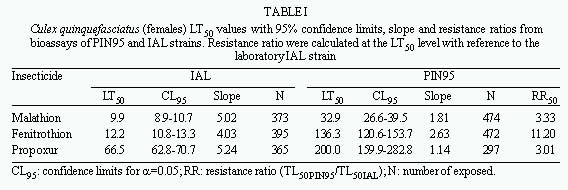To establish an insecticidal resistance surveillance program, Culex quinquefasciatus mosquitoes from São Paulo, Brazil, were colonized (PIN95 strain) and analyzed for levels of resistance. The PIN95 strain showed low levels of resistance to organophosphates [malathion (3.3-fold), fenitrothion (11.2-fold)] and a carbamate [propoxur (3.0-fold)]. We also observed an increase of 7.4 and 9.9 in a and b esterase activities, respectively, when compared with the reference IAL strain. An alteration in the sensitivity of acetylcholinesterase to insecticide inhibition was also found in the PIN95 mosquitoes. The resistant allele (Ace.1R), however, was found at low frequencies (0.12) and does not play an important role in the described insecticide resistance. One year later, Cx. quinquefasciatus mosquitoes were collected (PIN96 strain) at the same site and compared to the PIN95 strain. The esterase activity patterns observed for the PIN96 strain were similar to those of the PIN95 mosquitoes. However the occurrence of the Ace.1R allele was statistically higher in the PIN96 strain. The results show that esterase-based insecticide resistance was established in the PIN95 Cx. quinquefasciatus population and that an acethylcholinesterase based resistant mechanism has been selected for. A continuous monitoring of this phenomenon is fundamental for rational mosquito control and insecticide application programs.
Culex quinquefasciatus; insecticide resistance; acethylcholinesterase; esterase; control



